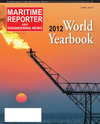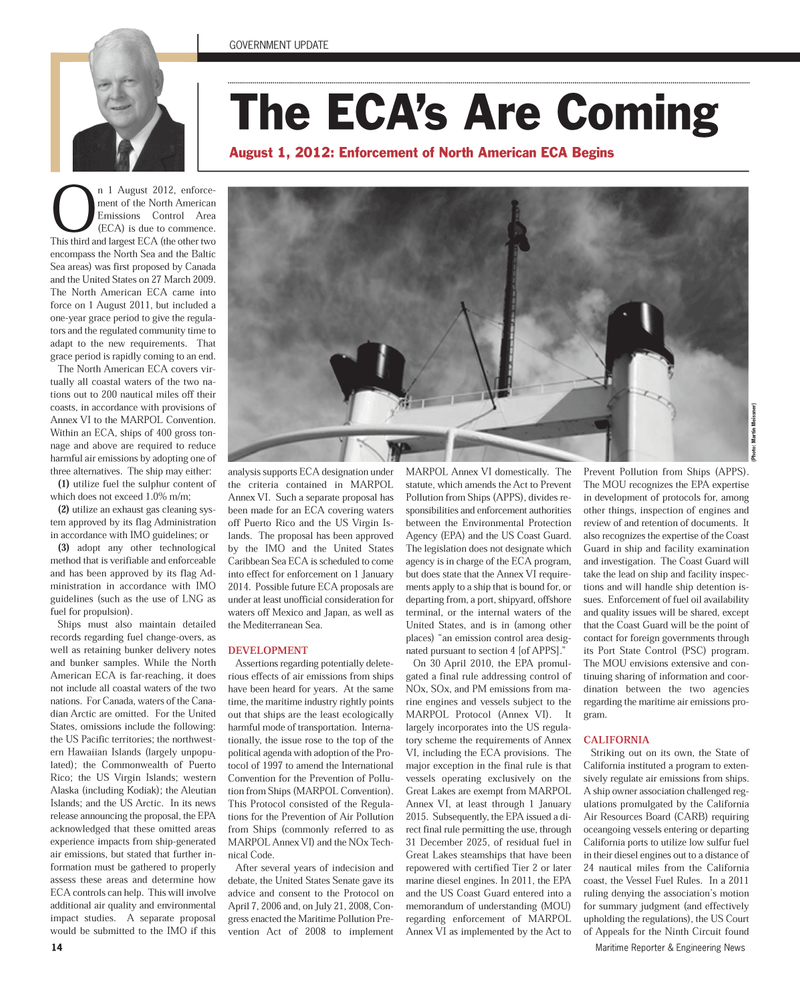
Page 14: of Maritime Reporter Magazine (June 2012)
Annual World Yearbook
Read this page in Pdf, Flash or Html5 edition of June 2012 Maritime Reporter Magazine
14Maritime Reporter & Engineering News On 1 August 2012, enforce- ment of the North American Emissions Control Area (ECA) is due to commence.This third and largest ECA (the other two encompass the North Sea and the BalticSea areas) was first proposed by Canada and the United States on 27 March 2009.The North American ECA came into force on 1 August 2011, but included a one-year grace period to give the regula- tors and the regulated community time to adapt to the new requirements. That grace period is rapidly coming to an end.The North American ECA covers vir- tually all coastal waters of the two na- tions out to 200 nautical miles off their coasts, in accordance with provisions of Annex VI to the MARPOL Convention. Within an ECA, ships of 400 gross ton- nage and above are required to reduce harmful air emissions by adopting one ofthree alternatives. The ship may either: (1)utilize fuel the sulphur content ofwhich does not exceed 1.0% m/m; (2)utilize an exhaust gas cleaning sys- tem approved by its flag Administration in accordance with IMO guidelines; or (3)adopt any other technological method that is verifiable and enforceable and has been approved by its flag Ad- ministration in accordance with IMOguidelines (such as the use of LNG asfuel for propulsion). Ships must also maintain detailedrecords regarding fuel change-overs, as well as retaining bunker delivery notes and bunker samples. While the North American ECA is far-reaching, it does not include all coastal waters of the two nations. For Canada, waters of the Cana- dian Arctic are omitted. For the United States, omissions include the following: the US Pacific territories; the northwest- ern Hawaiian Islands (largely unpopu- lated); the Commonwealth of PuertoRico; the US Virgin Islands; western Alaska (including Kodiak); the Aleutian Islands; and the US Arctic. In its news release announcing the proposal, the EPA acknowledged that these omitted areas experience impacts from ship-generated air emissions, but stated that further in- formation must be gathered to properly assess these areas and determine how ECA controls can help. This will involve additional air quality and environmental impact studies. A separate proposal would be submitted to the IMO if this analysis supports ECA designation underthe criteria contained in MARPOLAnnex VI. Such a separate proposal has been made for an ECA covering waters off Puerto Rico and the US Virgin Is- lands. The proposal has been approved by the IMO and the United StatesCaribbean Sea ECA is scheduled to comeinto effect for enforcement on 1 January 2014. Possible future ECA proposals areunder at least unofficial consideration for waters off Mexico and Japan, as well as the Mediterranean Sea.DEVELOPMENTAssertions regarding potentially delete- rious effects of air emissions from shipshave been heard for years. At the same time, the maritime industry rightly pointsout that ships are the least ecologicallyharmful mode of transportation. Interna- tionally, the issue rose to the top of the political agenda with adoption of the Pro-tocol of 1997 to amend the InternationalConvention for the Prevention of Pollu- tion from Ships (MARPOL Convention). This Protocol consisted of the Regula- tions for the Prevention of Air Pollution from Ships (commonly referred to asMARPOL Annex VI) and the NOx Tech- nical Code.After several years of indecision and debate, the United States Senate gave its advice and consent to the Protocol onApril 7, 2006 and, on July 21, 2008, Con-gress enacted the Maritime Pollution Pre-vention Act of 2008 to implement MARPOL Annex VI domestically. The statute, which amends the Act to Prevent Pollution from Ships (APPS), divides re- sponsibilities and enforcement authoritiesbetween the Environmental Protection Agency (EPA) and the US Coast Guard. The legislation does not designate which agency is in charge of the ECA program, but does state that the Annex VI require- ments apply to a ship that is bound for, or departing from, a port, shipyard, offshore terminal, or the internal waters of the United States, and is in (among otherplaces) ?an emission control area desig-nated pursuant to section 4 [of APPS].? On 30 April 2010, the EPA promul- gated a final rule addressing control of NOx, SOx, and PM emissions from ma-rine engines and vessels subject to the MARPOL Protocol (Annex VI). It largely incorporates into the US regula- tory scheme the requirements of Annex VI, including the ECA provisions. The major exception in the final rule is that vessels operating exclusively on the Great Lakes are exempt from MARPOL Annex VI, at least through 1 January 2015. Subsequently, the EPA issued a di- rect final rule permitting the use, through 31 December 2025, of residual fuel inGreat Lakes steamships that have been repowered with certified Tier 2 or later marine diesel engines. In 2011, the EPA and the US Coast Guard entered into amemorandum of understanding (MOU)regarding enforcement of MARPOL Annex VI as implemented by the Act to Prevent Pollution from Ships (APPS). The MOU recognizes the EPA expertise in development of protocols for, among other things, inspection of engines andreview of and retention of documents. It also recognizes the expertise of the Coast Guard in ship and facility examination and investigation. The Coast Guard will take the lead on ship and facility inspec- tions and will handle ship detention is-sues. Enforcement of fuel oil availability and quality issues will be shared, except that the Coast Guard will be the point ofcontact for foreign governments through its Port State Control (PSC) program.The MOU envisions extensive and con- tinuing sharing of information and coor- dination between the two agencies regarding the maritime air emissions pro- gram.CALIFORNIAStriking out on its own, the State of California instituted a program to exten-sively regulate air emissions from ships. A ship owner association challenged reg- ulations promulgated by the California Air Resources Board (CARB) requiringoceangoing vessels entering or departing California ports to utilize low sulfur fuel in their diesel engines out to a distance of24 nautical miles from the Californiacoast, the Vessel Fuel Rules. In a 2011 ruling denying the association?s motion for summary judgment (and effectively upholding the regulations), the US Court of Appeals for the Ninth Circuit found GOVERNMENT UPDATE The ECA?s Are Coming August 1, 2012: Enforcement of North American ECA Begins (Photo: Martin Meissner) MR June12 # 2 (9-16):MR Template 6/12/2012 8:42 AM Page 14

 13
13

 15
15
